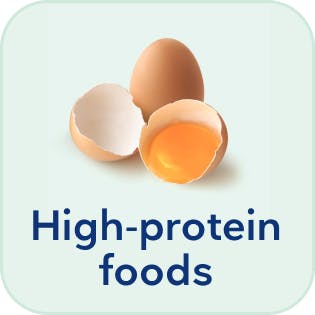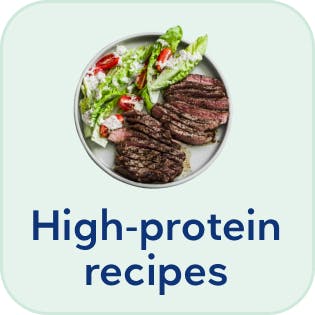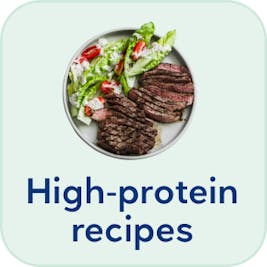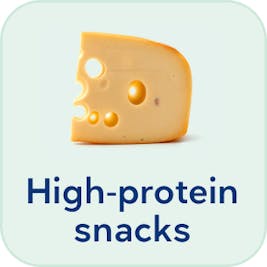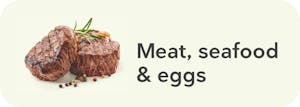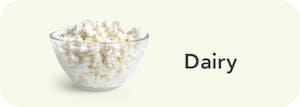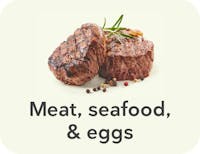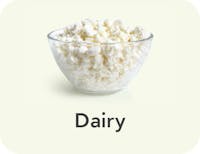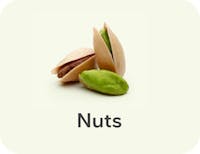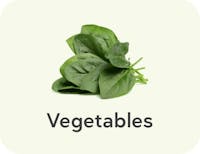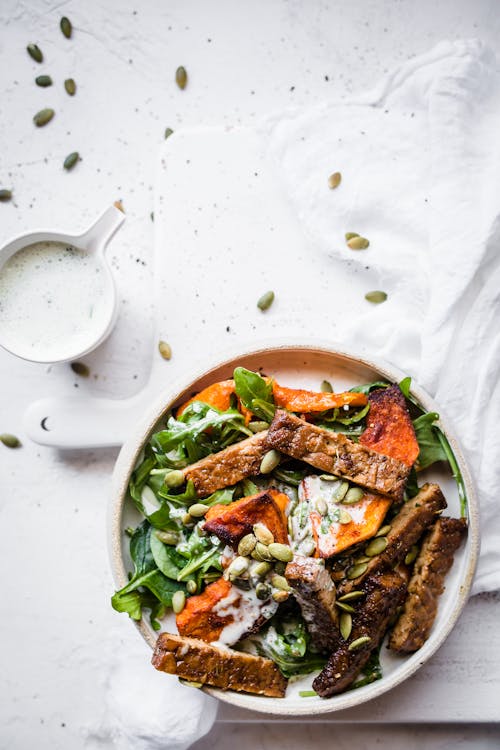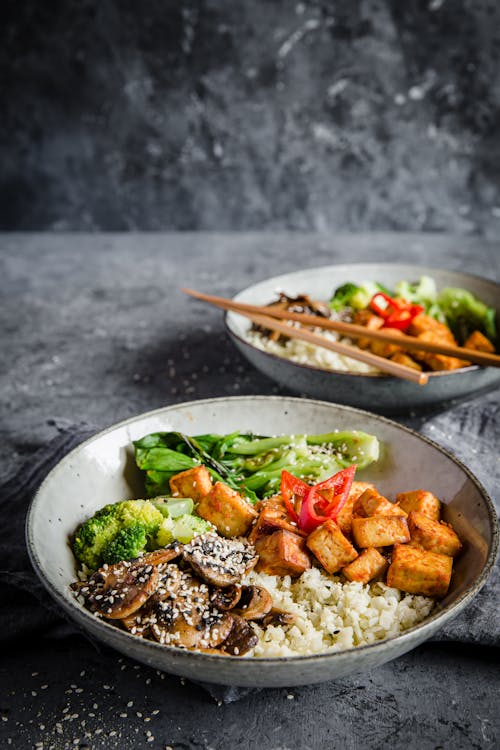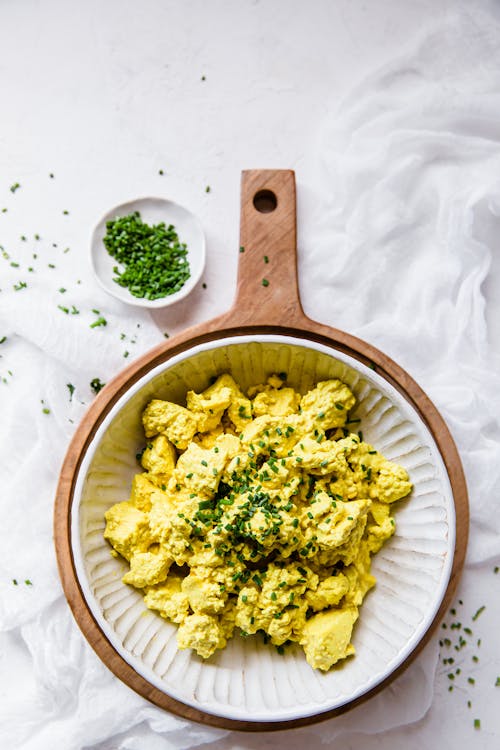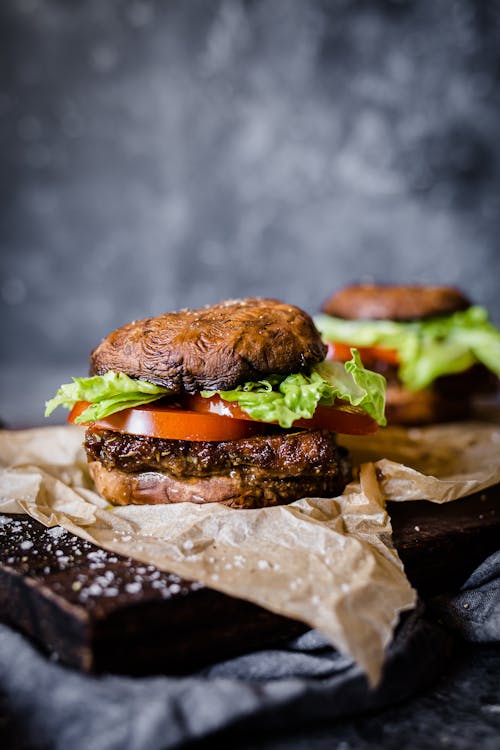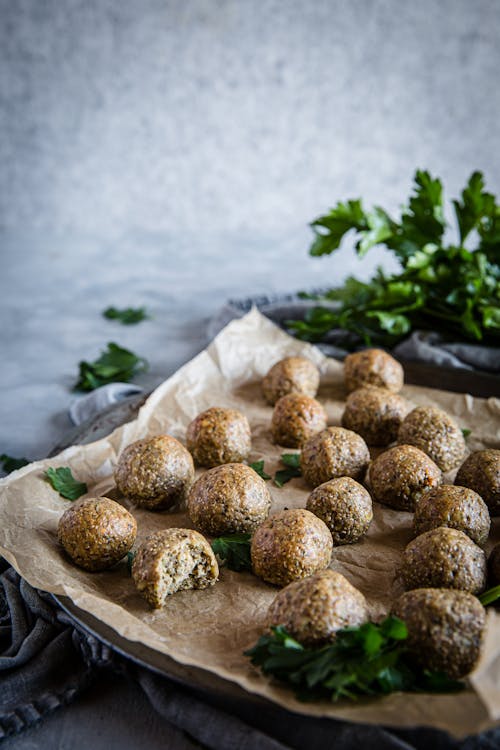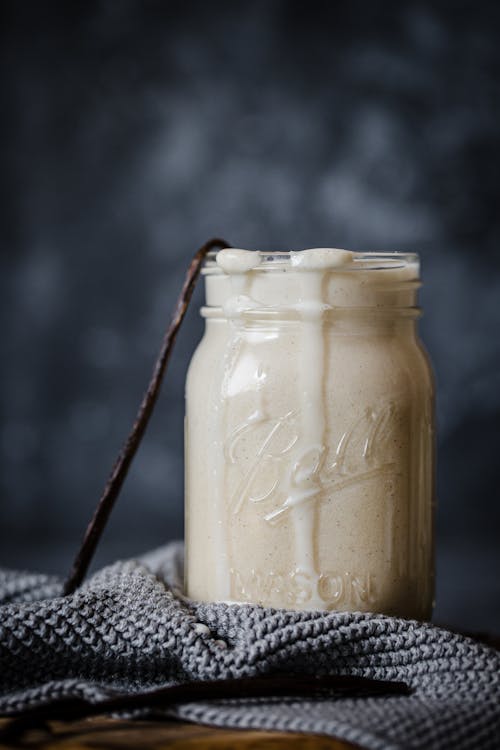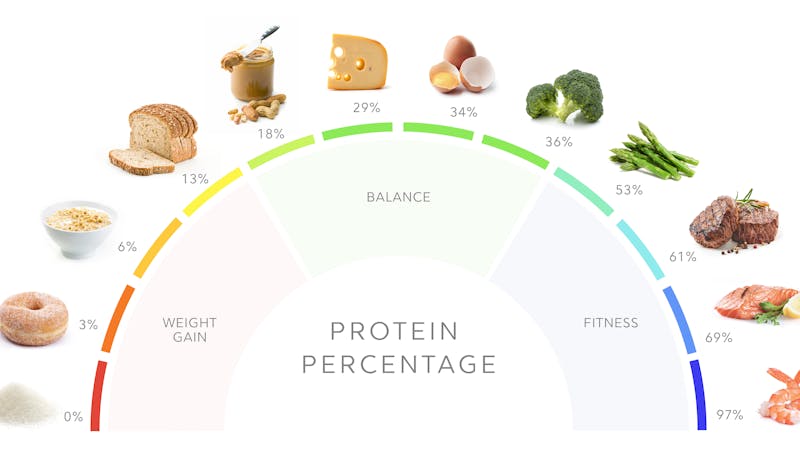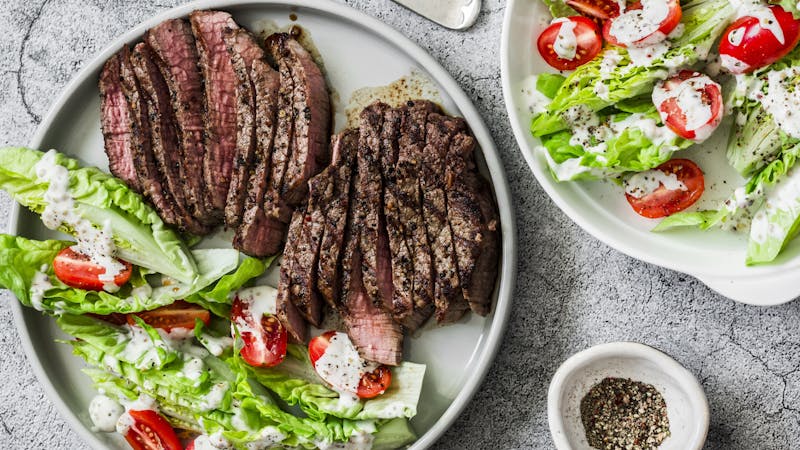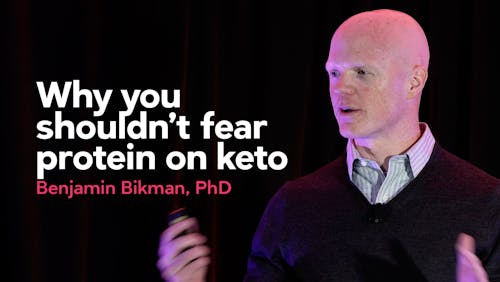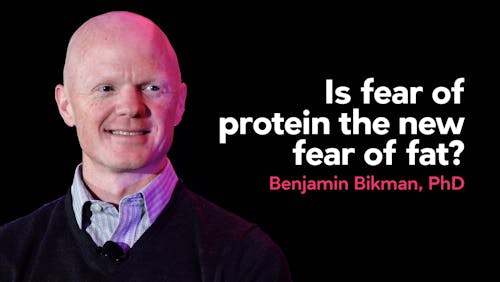The best plant-based
high-protein foods
Are you a vegan or vegetarian interested in learning which plant-based proteins are best for losing weight? Do you currently eat animal proteins but want to add more plant proteins to your daily meals?
One key to healthy weight loss is choosing high-protein foods that provide maximum satiety (feeling full and satisfied) per calorie. Also, as a plant-based eater, it’s important to get enough protein from a variety of sources on a daily basis.
In this guide, you’ll learn which plant foods can help you lose weight and meet your protein needs. You’ll also find our tips for including these high-protein vegan foods in your diet, along with tasty and healthy recipes to try.
The top 9 plant-based protein foods
- Seitan (vital wheat gluten): 77% protein
- Lupini beans: 55% protein
- Extra-firm tofu: 48% protein
- Canned black soybeans: 46% protein
- Lentils: 42% protein
- Edamame: 40% protein
- Tempeh: 40% protein
- Split peas: 37% protein
- Lima beans: 35% protein
If you want to go straight to the complete high-protein plant foods list, click here.
The image below shows the protein as a percentage of calories for different plant-based protein foods.The higher the number, the more protein the food provides per calorie.
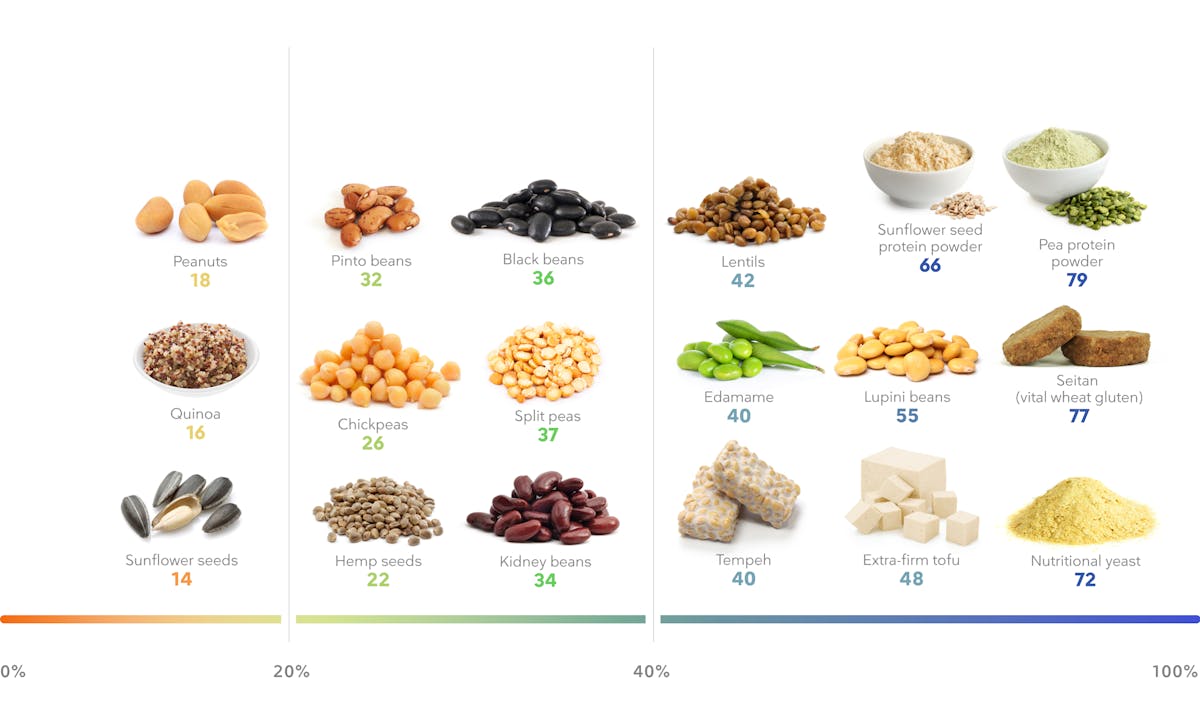


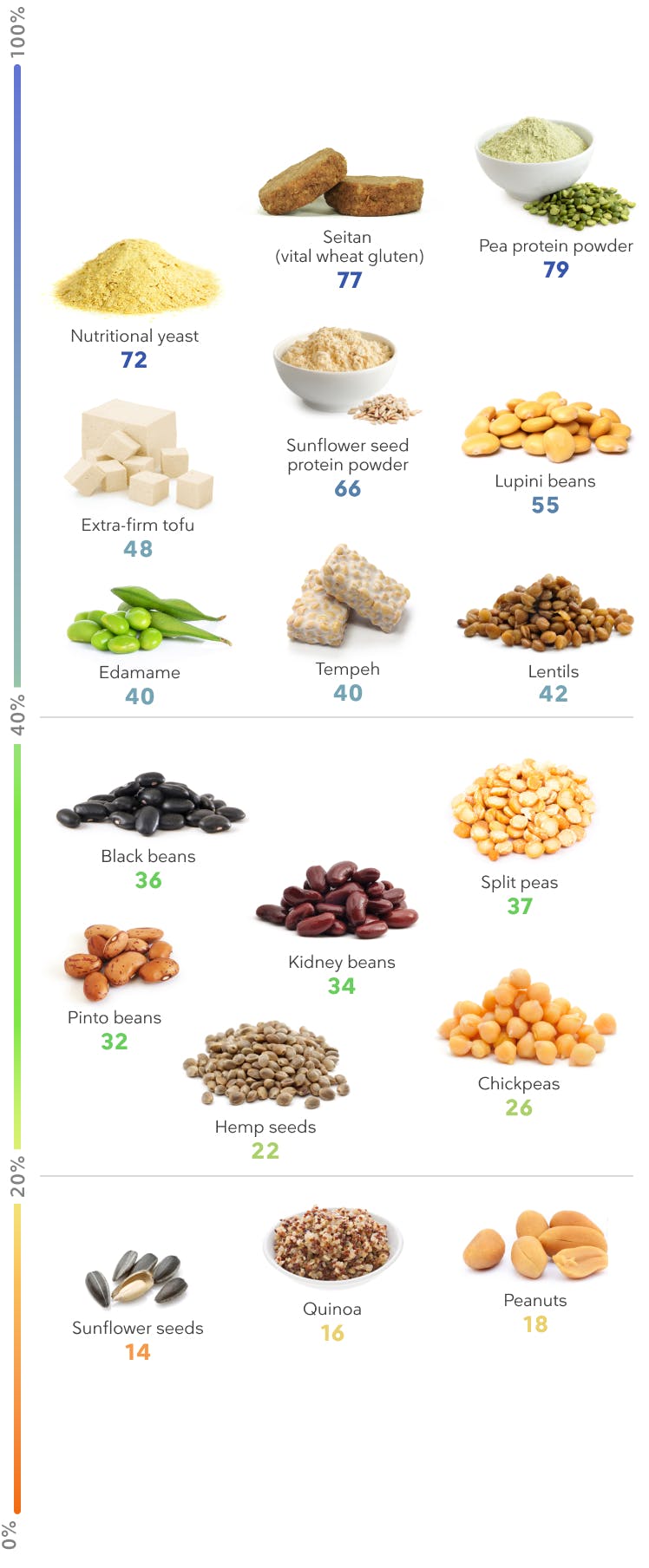


Key takeaways
Plant-based protein targets. Include a wide variety of high-protein plants in your diet to lose weight and meet your nutrition needs. Aim to get at least 30% of your calories from protein. Learn moreThe best plant-based high-protein foods. Enjoy beans, lentils, peas, seeds, nutritional yeast, soy, and seitan. Prioritize types with protein percentages above 35%. Learn more
Plant-based protein powders. Consider supplementing with plant-based protein powders, especially if you follow a keto or very low-carb diet. Learn more
More high-protein guides
More high-protein guides
How to meet protein targets with plant-based foods
Protein is a nutrient your body needs to stay strong and healthy. On a vegan or plant-based diet, getting enough protein may take a bit more strategy — but we’ll show you how to do it.
Essential amino acid needs
Twenty amino acids make up the “building blocks” of protein that your body uses to create muscle, skin, and hormones, among other functions.
Nine of these amino acids are essential, meaning your body cannot make them on its own. Instead, you need to get them from your food on a daily basis.1
Animal foods provide all of the essential amino acids in the amounts your body needs to survive and thrive. For this reason, they are often referred to as complete protein sources.
Although many plants contain all nine essential amino acids, in most cases, one or more of these amino acids are only present in small amounts. Additionally, the protein in most plants isn’t digested and absorbed as easily as the protein in animal foods.2 For this reason, most plants are referred to as incomplete proteins.3
Certain plants — such as hemp seed, quinoa, and nutritional yeast — have been described by some as complete proteins. However, each of these plants is slightly low in one or more of the essential amino acids.4It’s more accurate to say that these foods provide “nearly complete” protein.
By contrast, soy is considered a complete protein because it provides all nine essential amino acids in amounts comparable to the milk proteins casein and whey. Your body also digests and absorbs soy protein efficiently.5
Fortunately, meeting essential amino acid needs on a vegan diet is easy if you eat a wide range of different foods.
Here is a list of different types of plant foods that combine to make complete protein:
- Beans and legumes + nuts, seeds, or grains
- Grains + beans or legumes
- Vegetables + nuts, seeds, or grains
Do you have to make a conscious effort to combine different plant proteins at each meal? No. Eating enough protein from a variety of plants every day ensures that you meet your amino acid needs.6
Aim for a high protein percentage
Results from high-quality clinical trials show that getting plenty of protein can help you lose weight and prevent muscle loss.7Vegan and vegetarian diets can also be beneficial for weight loss.8
For healthy weight loss on a plant-based diet, choose foods that have a high protein percentage. This percentage tells you how much of a food’s calories, excluding fiber, come from protein.9
Try to choose plant foods with protein percentages of 35% or more most of the time. We’ll tell you what those are in the list below. These foods are your best plant-based protein options.
Even if you don’t want to lose weight, it’s important to eat plant foods with high protein percentages to prevent muscle loss. Add calories by eating foods higher in fat and carbs after you’ve covered your protein needs.
How much protein do you need?
Because most plant proteins are less easily digested and absorbed by your body than animal proteins, prioritizing protein intake is key when eating a plant-based or vegan diet.
How much do you need? As a general estimate, you could aim to eat at least 100 grams of protein per day if you’re a woman and 140 grams if you’re a man of average height and build. Try to eat more if you’re a man taller than 6 feet (183 cm) or a woman taller than 5 feet 6 inches (168 cm) or if you’re very physically active. Eat less if you’re shorter or have a petite frame.
This guide provides both the protein percentages and grams per serving for plant foods.10 Note that these are based on average values. Protein percentages and gram amounts can vary depending on food processing, preparation, and other factors. Protein amounts of prepared foods can also vary from brand to brand.
Eating low carb as a vegan
Although it’s important to get enough protein, there are other things to keep in mind when eating a low-carb vegan diet. Learn more in our guide, How to eat low carb as a vegan.
The best plant-based high-protein foods
Eat a variety of these high-protein vegan foods as part of your daily diet. Remember, the goal is to prioritize those with a protein percentage of 35% or higher.
Beans and lentils
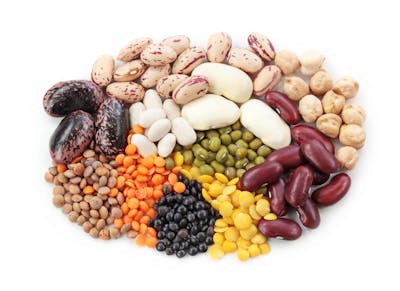



These legumes have a lot going for them. For starters, they’re a great source of potassium, magnesium, folate, and fiber.
Beans and lentils are filling because they’re high in both protein and fiber. Some studies suggest that including them in your diet may help you lose weight.11
Although all types of beans can help meet your protein needs, some have higher protein percentages than others. So take note of their protein profiles — as well as the carb amounts if you eat a low-carb diet.
Below are the protein percentages and grams of protein, fiber, and net carbs per 1 cup (170 to 190 grams) of cooked beans and lentils.
- Lupini (lupin) beans:
Protein percentage: 55%
26 grams of protein, 5 grams of fiber, and 11 grams of net carbs per serving12 - Lentils:
Protein percentage: 42%
18 grams of protein, 16 grams of fiber, and 23 grams of net carbs per serving - Black beans:
Protein percentage: 36%
15 grams of protein, 15 grams of fiber, and 25 grams of net carbs per serving - Lima beans
Protein percentage: 35%
15 grams of protein, 13 grams of fiber, and 26 grams of net carbs per serving - Kidney beans:
Protein percentage: 34%
15 grams of protein, 13 grams of fiber, and 27 grams of net carbs per serving - Navy beans:
Protein percentage: 33%
15 grams of protein, 19 grams of fiber, and 28 grams of net carbs per serving - Pinto beans:
Protein percentage: 32%
15 grams of protein, 15 grams of fiber, and 30 grams of net carbs per serving
Tips for serving beans and legumes:
- Create chili with canned beans, tomatoes, mushrooms or other vegetables, and chili powder. (Add cayenne or jalapeño peppers if you prefer it extra spicy.)
- Make a batch of lentil soup with kale or other greens.
- Add canned cooked kidney beans or black beans to a salad.
Peas
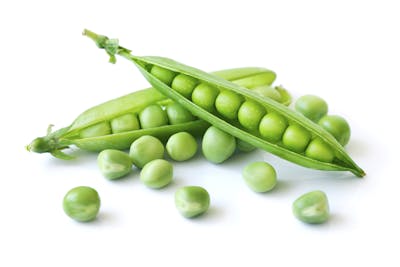



Peas are also a vegan protein that can help you feel full and satisfied.13
Peas have lower protein percentages and provide less protein per serving than most beans. Additionally, they’re high in net carbs. Feel free to include them in your plant-based lifestyle, but keep portions small if you follow a keto or very low-carb diet.
Below are the protein percentages and grams of protein, fiber, and net carbs per 1 cup (160 to 190 grams) of cooked beans and lentils.
- Split peas
Protein percentage: 37%
16 grams of protein, 16 grams of fiber, and 25 grams of net carbs per serving - Green peas
Protein percentage: 35%
9 grams of protein, 9 grams of fiber, and 16 grams of net carbs per serving - Chickpeas (garbanzo beans)
Protein percentage: 26%
15 grams of protein, 12 grams of fiber, and 32 grams of net carbs per serving
Tips for serving peas:
- Make vegan split pea soup by replacing the ham with smoked paprika.
- Create quick homemade hummus. Puree canned chickpeas with a bit of tahini, garlic, lemon juice, and cumin.
- Add canned or cooked chickpeas to salads.
Seeds
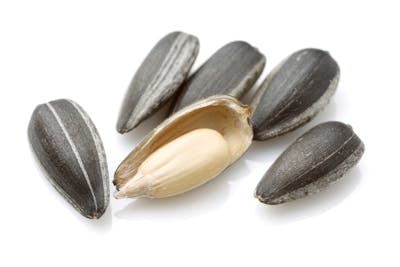



While most seeds are high in fat and low in carbs, wild rice, quinoa, and buckwheat are low in fat and high in carbs. However, all seeds have low protein percentages and don’t provide a lot of protein per serving.
The good news is, seeds can still contribute to your daily protein needs. Just make sure to also eat plenty of high-protein vegan foods from the other categories in this guide.
Below are the protein percentages and grams of protein, fiber, and net carbs per serving of seeds. (Serving sizes vary; see specific foods.)
- Hemp seeds, hulled (also called hemp hearts):
Protein percentage: 22%
10 grams of protein, 1 gram of fiber, and 1.5 grams of net carbs per ounce (30 grams); approximately three tablespoons - Pumpkin seeds:
Protein percentage: 22%
9 grams of protein, 2 grams of fiber, and 1 gram of net carbs per ounce (30 grams); approximately one-quarter cup - Sacha inchi seeds:
Protein percentage: 20%
8 grams of protein, 4 grams of fiber, and 1 gram of net carbs per ounce (30 grams); approximately one-quarter cup - Chia seeds:
Protein percentage: 18%
5 grams of protein, 10 grams of fiber, and 2 grams of net carbs per ounce (30 grams); approximately two tablespoons - Quinoa:
Protein percentage: 16%
8 grams of protein, 5 grams of fiber, and 34 grams of net carbs per 6 ounces (185 grams) of cooked quinoa; approximately one cup - Wild rice:
Protein percentage: 16%
7 grams of protein, 3 grams of fiber, and 32 grams of net carbs per 5.5 ounces (164 grams) of cooked buckwheat; approximately one cup - Buckwheat:
Protein percentage: 16%
6 grams of protein, 5 grams of fiber, and 29 grams of net carbs per 5.5 ounces (168 grams) of cooked buckwheat; approximately one cup - Sunflower seeds:
Protein percentage: 14%
6 grams of protein, 2.5 grams of fiber, and 4 grams of net carbs per ounce (30 grams); approximately one-quarter cup
Tips for serving seeds:
- Include hemp hearts in a salad.
- Stir pumpkin seeds into chili.
- Make chia pudding. Combine two tablespoons of chia seeds with one-half cup water. Add cinnamon, vanilla, and optional sweetener to taste. Then, mix well. Let the mixture stand for a minimum of 15 minutes before consuming it.
Nutritional yeast
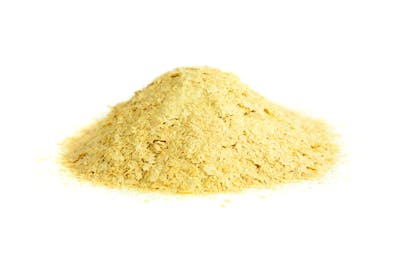



Nutritional yeast comes from Saccharomyces cerevisiae, the same yeast species used to make beer and bread. However, unlike live yeast that causes bread to rise, nutritional yeast is treated with heat, which kills the yeast cells. Next, it is dried into a powder or flakes and packaged for sale.
Besides being an excellent vegan protein option, nutritional yeast contains several B vitamins like riboflavin, niacin, and vitamin B6. Some types are fortified with vitamin B12.
Below are the protein percentage and grams of protein, fiber, and net carbs per ounce (30 grams) of nutritional yeast flakes, approximately one-quarter cup:
Nutritional yeast flakes:
Protein percentage: 72%
16 grams of protein, 6 grams of fiber, and 4 grams of net carbs per serving
Purchase nutritional yeast flakes or powder in the spice section of your health food store or online. How does it taste? People often describe the flavor as nutty or earthy. And for many, it may be an acquired taste.
Tips for eating nutritional yeast:
- Make a cheesy vegan sauce. Mix nutritional yeast with water, salt, and oil, heat in a saucepan, and spoon over cooked vegetables.
- Sprinkle it on kale chips with a bit of salt.
- Stir it into soup or chili for a change of pace from the usual taste and texture.
Soy




In the past, soy received its share of controversy based on very weak animal and test-tube research that suggested it could potentially increase the risk of cancer and other health problems.16 However, most of the high-quality human research on soy shows that it is safe and may reduce — rather than increase — disease risk in some cases.17
For vegetarians and vegans in particular, the benefits of consuming soy appear to greatly outweigh the risks.18
Health effects of soy
Are you concerned about the health effects of soy? You can read more about soy in the Diet Doctor food policy.Soy can be valuable for plant-based low-carb eaters because, unlike other legumes, it is both high in protein and low in net carbs. We recommend choosing tofu, edamame, soybeans, tempeh, and nattō rather than soy protein powders and other highly processed products.
Below are the protein percentages and grams of protein, fiber, and net carbs per serving of soy (serving sizes vary; see specific foods).
- Tofu (extra firm):
Protein percentage: 48%
24 grams of protein, 3 grams of fiber, and 2 grams of net carbs per 8 ounces (240 grams); approximately one cup - Canned black soybeans:
Protein percentage: 46%
21 grams of protein, 7 grams of fiber, and 2 grams of net carbs per 4 ounces (120 grams); approximately two-thirds cup - Tempeh:
Protein percentage: 40%
20 grams of protein, 4 grams of fiber, and 7 grams of net carbs per 3.5 ounces (100 grams); approximately two-thirds cup - Edamame (green soybeans):
Protein percentage: 40%
19 grams of protein, 8 grams of fiber, and 6 grams of net carbs per 5.5 ounces (155 grams); approximately one cup - Nattō:
Protein percentage: 38%
22 grams of protein, 6 grams of fiber, and 8 grams of net carbs per 4 ounces (120 grams); approximately two-thirds cup
Tips for serving soy:
- Make a stir-fry with tofu and your favorite vegetables.
- Grill slices of tempeh seasoned with your favorite herbs and olive oil.
- Eat edamame as a meal or snack. (Look for packs of dry-roasted edamame at your grocery store.)
Seitan (vital wheat gluten)
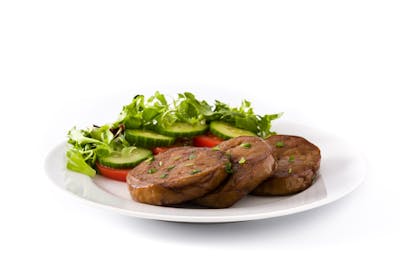



Gluten is the main protein found in wheat and other grains like barley and rye. However, unlike most grain products, seitan is very low in carbs. It’s also a good source of minerals like iron and selenium.
Seitan is made by mixing water with wheat flour to form a dough, which is kneaded and rinsed repeatedly to remove the starch. After several rinsings, only gluten strands remain. This final product is seitan, a concentrated protein source that’s typically seasoned with soy sauce before cooking.
If you have celiac disease or are sensitive to gluten, seitan isn’t for you. But if you tolerate gluten, consider giving seitan a try.
Below are the protein percentages and grams of protein, fiber, and net carbs per 3.5 ounces (100 grams) of seitan, approximately one-third cup:
Seitan:
Protein percentage: 76%
22 grams of protein, 1 gram of fiber, and 4 grams of net carbs per serving
Tips for serving seitan:
- Use it as a ground meat substitute in a taco salad.
- Include it as the main protein in a soup or stew with vegetables.
- Grill seitan kebabs with eggplant, zucchini, and mushrooms.
Plant-based protein powders




Plant-based protein powders are a convenient way to get a hefty protein dose without a lot of carbs. Why? Because they often have exceptionally high protein percentages.
If you decide to supplement with protein powders, choose types without added sugar. Look for unflavored powders that contain only the plant protein (for example, pea protein). Or select brands flavored with any of the sugar-free sweeteners we recommend.
Below are the protein percentages and grams of protein, fiber, and net carbs per ounce (30 grams) of protein powder. Note: These are average values. When choosing a protein powder, be sure to read nutrition labels since protein and carb content can vary among brands, resulting in higher or lower protein percentages.
- Plant protein blends that include multiple seeds, legumes, and grains:
Protein percentage: 80%
22 grams of protein, 1 gram of fiber, and 1 gram of net carbs per serving - Pea protein powder:
Protein percentage: 79%
24 grams of protein, 2 grams of fiber, and 1 gram of net carbs per serving - Hemp-seed protein powder:
Protein percentage: 67%
15 grams of protein, 8 grams of fiber, and 1 gram of net carbs per serving - Sunflower-seed protein powder:
Protein percentage: 66%
15 grams of protein, 2 grams of fiber, and 1 gram of net carbs per serving
Nuts
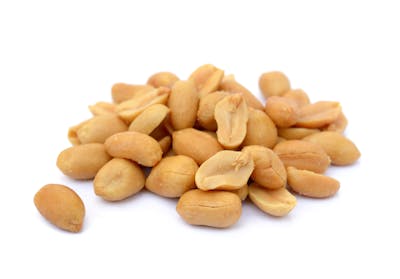



On the other hand, nuts have a lot of non-protein calories — and their delicious taste often makes them tempting to overeat. One handful can lead to another, then another, and so on.
Although nuts provide some protein, their protein percentages are low due to their high fat content. So they’re not one of the best plant-based protein sources. Portion out a small amount (one-quarter cup or less) to top a salad or eat as a snack.
Peanuts, technically a legume, have the highest protein percentage of all nuts at 18%. Which nut has the lowest protein percentage? Macadamia nuts. Although they’re prized for their very low carb count, macadamias have a protein percentage of only 4%.
To read more about our the best high-protein nuts, check out this guide.
Vegetables




Compared to other foods on this list, vegetables don’t provide a lot of protein. However, many vegetables have high protein percentages because they’re so low in fat and net carbs.
Vegetables contain some of the essential amino acids that are limited in other plant foods. So, including them at every meal can improve the overall protein quality of your diet.20
Vegetable protein percentages span a large range, with spinach topping the list at 57%. Yellow bell peppers rank last among non-starchy vegetables at 15% protein. And parsnips are at the bottom of the protein percentage scale for starchy vegetables at 8%.
To read more about our the best high-protein vegetables, check out this guide.
Plant-based recipes
Learn more about protein
The best plant-based high-protein foods - the evidence
This guide is written by Franziska Spritzler, RD and was last updated on June 17, 2022. It was medically reviewed by Dr. Bret Scher, MD on March 11, 2022.
The guide contains scientific references. You can find these in the notes throughout the text, and click the links to read the peer-reviewed scientific papers. When appropriate we include a grading of the strength of the evidence, with a link to our policy on this. Our evidence-based guides are updated at least once per year to reflect and reference the latest science on the topic.
All our evidence-based health guides are written or reviewed by medical doctors who are experts on the topic. To stay unbiased we show no ads, sell no physical products, and take no money from the industry. We're fully funded by the people, via an optional membership. Most information at Diet Doctor is free forever.
Read more about our policies and work with evidence-based guides, nutritional controversies, our editorial team, and our medical review board.
Should you find any inaccuracy in this guide, please email andreas@dietdoctor.com.
Your body can recycle and reuse some of these amino acids, but most of them must be replenished by your diet:
International Journal for Vitamin and Nutrition Research 2011: Protein turnover, ureagenesis and gluconeogenesis [overview article; ungraded] ↩
The protein digestibility corrected amino acid score (PDCAAS) compares the amino acid content of a protein (such as beans or wheat) to a reference protein believed to meet human essential amino acid requirements. This creates a ratio known as the amino acid score or chemical score. This score is then corrected for the amount of protein that is digested and used by the body. Milk, eggs, and other animal proteins have PDCAAS scores of about 1.0, whereas plant proteins (with the exception of soy) have PDCAAS scores ranging from 0.4 to 0.88:
Nutrients 2020: Plant proteins: Assessing their nutritional quality and effects on health and physical function [review article; ungraded]
Nutrition Reviews 2019: Maximizing the intersection of human health and the health of the environment with regard to the amount and type of protein produced and consumed in the United States [review article; ungraded] ↩
The two requirements for a protein to be considered complete are having adequate levels of essential amino acids to support growth and having protein that is well digested and absorbed:
Nutrients 2020: Plant proteins: Assessing their nutritional quality and effects on health and physical function [review article; ungraded] ↩
Hemp is slightly low in the essential amino acids lysine and leucine and has a protein digestibility-corrected amino acid score (PDCAAS) of 0.63 to 0.66:
Journal of Agricultural and Food Chemistry 2010: Evaluating the quality of protein from hemp seed (Cannabis sativa L.) products through the use of the protein digestibility-corrected amino acid score method [laboratory study; ungraded]
Amino Acids 2018: Protein content and amino acid composition of commercially available plant-based protein isolates [laboratory study; ungraded]
Quinoa is slightly low in the essential amino acid leucine and has a PDCAAS of 0.55 to 0.78:
Food Research International 2020: The functional attributes of Peruvian (Kankolla and Blanca juli blend) and Northern quinoa (NQ94PT) flours and protein isolates, and their protein quality [laboratory study; ungraded]
Frontiers in Nutrition 2020: Seed composition and amino acid profiles for quinoa grown in Washington State [laboratory study; ungraded]
Nutrients 2020: Plant proteins: Assessing their nutritional quality and effects on health and physical function [review article; ungraded]
Nutritional yeast is slightly low in the essential amino acid methionine and has a PDCAAS of 0.65 to 0.68:
Journal of Agricultural and Food Chemistry 2008: Study of the lipidic and proteic composition of an industrial filmogenic yeast with applications as a nutritional supplement [laboratory study; ungraded]
Journal of Agricultural and Food Chemistry 2005: Yeast (Saccharomyces cerevisiae) protein concentrate: preparation, chemical composition, and nutritional and functional properties [laboratory study; ungraded] ↩
Soy protein has a protein digestibility corrected amino acid score (PDCAAS) of about 1.00, similar to casein and whey:
Nutrients 2020: Plant proteins: Assessing their nutritional quality and effects on health and physical function [review article; ungraded] ↩
The position of protein researchers and the Academy of Nutrition and Dietetics is that complementary plant proteins should be consumed within a 24-hour period, not necessarily at every meal:
Nutrition Reviews 2019: Maximizing the intersection of human health and the health of the environment with regard to the amount and type of protein produced and consumed in the United States [review article; ungraded]
Journal of the Academy of Nutrition and Dietetics 2016: Position of the Academy of Nutrition and Dietetics: vegetarian diets [position statement; ungraded]
The American Journal of Clinical Nutrition 1994: Plant proteins in relation to human protein and amino acid nutrition [review article; ungraded] ↩
Systematic reviews of randomized controlled trials — considered the strongest type of evidence — demonstrate that higher-protein diets tend to help people feel full and retain muscle while losing weight:
Journal of the American College of Nutrition 2004: The effects of high protein diets on thermogenesis, satiety and weight loss: a critical review [systematic review of randomized trials; strong evidence]
Nutrition Reviews 2016: Effects of dietary protein intake on body composition changes after weight loss in older adults: a systematic review and meta-analysis [systematic review of randomized trials; strong evidence]
The Journal of Nutrition 2013: Normal protein intake is required for body weight loss and weight maintenance, and elevated protein intake for additional preservation of resting energy expenditure and fat free mass [randomized trial; moderate evidence] ↩
In a systematic review of randomized controlled trials comparing a low-fat vegan diet to an omnivore diet, vegan diets resulted in greater or equal weight loss, although results varied due to different dietary protocols among the trials:
Diabetes, Metabolic Syndrome and Obesity 2020: Effects of plant-based diets on weight status: A systematic review [strong evidence] ↩
Fiber isn’t included in the calorie count because it’s generally accepted that the human body doesn’t produce the enzymes needed to break down fiber:
Gut Microbes 2017: Dietary fiber and prebiotics and the gastrointestinal microbiota [overview article; ungraded]
Instead, fiber passes through your system until it reaches your colon, where it is either fermented by bacteria or eliminated, depending on the type:
International Journal of Molecular Sciences 2017: Gut fermentation of dietary fibres: physico-chemistry of plant cell walls and implications for health [overview article; ungraded] ↩
We obtained nutrition information from FoodData Central, the USDA’s nutrient profile database. For the few foods not listed in the USDA database, we calculated average values from other sources or used the nutrition information listed by the manufacturer. ↩
This may or may not be true for people on low-carb diets: At this time, there is no research comparing a low-carb diet with beans to a low-carb diet without beans:
The American Journal of Clinical Nutrition 2014: Effects of dietary pulse consumption on body weight: a systematic review and meta-analysis of randomized controlled trials [strong evidence] ↩
Published carbohydrate values for lupini beans vary greatly. However, they appear to be lower in carbs than other beans and legumes. ↩
In one trial, people reported similar satiety after eating a pea-based meal compared a meat-based meal with the same amount of fiber:
Nutrients 2018: Protein from meat or vegetable sources in meals matched for fiber content has similar effects on subjective appetite sensations and energy intake: A randomized acute cross-over meal test study [moderate evidence] ↩
Despite its name, buckwheat is not related to wheat and contains no gluten. ↩
Nutrients 2020: Plant proteins: Assessing their nutritional quality and effects on health and physical function [review article; ungraded] ↩
Soy contains isoflavones, a phytoestrogen or plant compound with a structure similar to estrogen. Isoflavones are found in soy and some other legumes and seeds, such as flaxseed. ↩
This is true for observational studies spanning many years as well as shorter but much higher-quality clinical trials:
Advances in Nutrition 2018: Associations between phytoestrogens, glucose homeostasis, and risk of diabetes in women: a systematic review and meta-analysis [meta-analysis of randomized and observational trials; moderate evidence]
PloS One 2013: Soy, red clover, and isoflavones and breast cancer: a systematic review [meta-analysis of randomized and observational trials; moderate evidence]
Gynecological Endocrinology 2013: Endometrial, breast and liver safety of soy isoflavones plus Lactobacillus sporogenes in post-menopausal women [randomized trial; moderate evidence]
Reproductive Toxicology 2020 Neither soy nor isoflavone intake affects male reproductive hormones: An expanded and updated meta-analysis of clinical studies [review of nonrandomized studies, weak evidence] ↩
Nutrients 2018: Soy, soy foods, and their role in vegetarian diets [overview article; ungraded]
↩Nuts are high in methionine but low in lysine, while beans are low in methionine but high in lysine. ↩
Essential amino acid content differs among vegetables.
In one study, researchers found that spinach contained all nine essential amino acids, although methionine was only present in small amounts:Food Chemistry 2011: Amino acid profile of raw and as-eaten products of spinach (Spinacia oleracea L.) [laboratory study; ungraded]
In an older study, cauliflower was found to be high in five of the nine essential amino acids, while carrots were found to be low in all of the essential amino acids:
The Journal of Nutrition 1949: The essential amino acid content of several vegetables [laboratory study; ungraded] ↩



